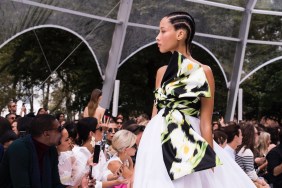Yesterday I posted an item about an 80% polyester Saint Laurent jacket with a £40,420 ($61,000) price tag. Even knowing that brands often mark up some of their trendiest pieces, I couldn’t believe anyone — even Saint Laurent — could get away with charging tens of thousands of dollars not for some rare, exquisite piece of finery, but for what’s essentially a piece of plastic.
Dana Thomas, the journalist who wrote Deluxe: How Luxury Lost Its Luster, an exposé about how luxury became a global, multibillion dollar industry, answered some of my questions about how brands determine price over email:
“When it comes to brands in major groups, the sole motivating factor is profits. The designers can dream up beautiful designs, but the number crunchers will cut costs wherever they can to raise the profit margin.
I also know that at times, designers like to use cheap fabrics not because they don’t cost much but because of the effect they cause creatively. But even if the fabric costs $2 a meter, and the dress costs $50 to produce, the number crunchers will price it at $3,000 retail. Because they can.
One designer told me a case where this happened and he even protested the high price. And the number crunchers didn’t care. Their argument: consumers will pay it. And they did, crazily enough.”
Saint Laurent is owned by Kering (formerly known as PPR), one of the largest luxury companies in the world; its other subsidiaries include Gucci, Stella McCartney, Alexander McQueen, Balenciaga, Sergio Rossi, Bottega Veneta.
It’s worth emphasizing that analysts, not designers, are most often the ones making decisions about how to price items — based on what they predict the item will sell for, not what it costs to make. Those of us that want to see fashion prices correspond more closely to quality need to educate ourselves about garment production and put pressure on brands to be more transparent about their manufacturing practices and policies. Anyone who can afford to pay more for clothing should make an effort to seek out garments that take time and skill to construct, use better quality materials and are made under good conditions for workers, with low environmental impact.
Previously: This 80% Saint Laurent Jacket Costs $61K








